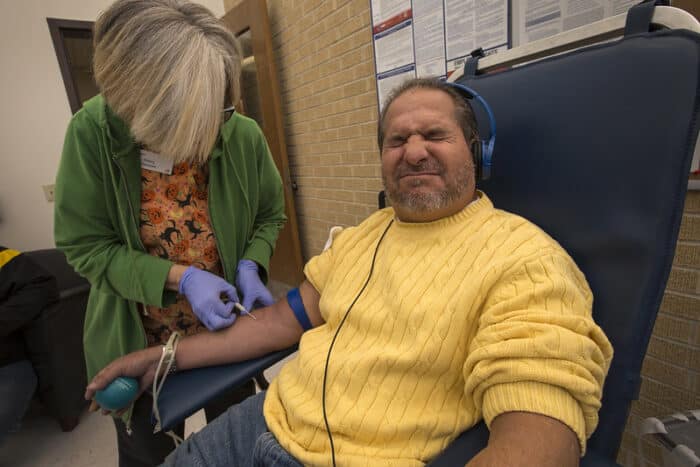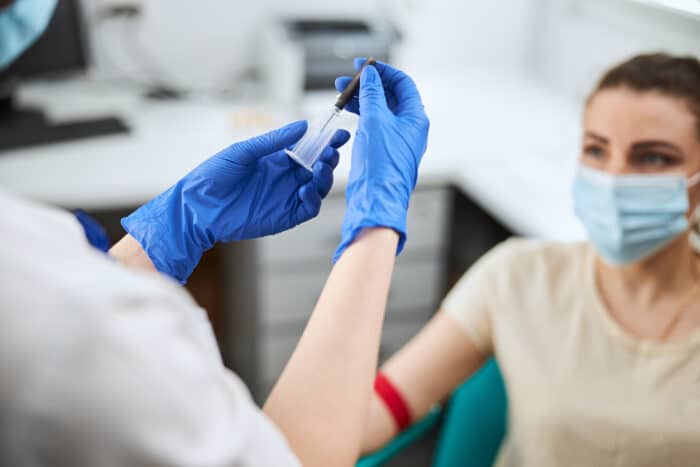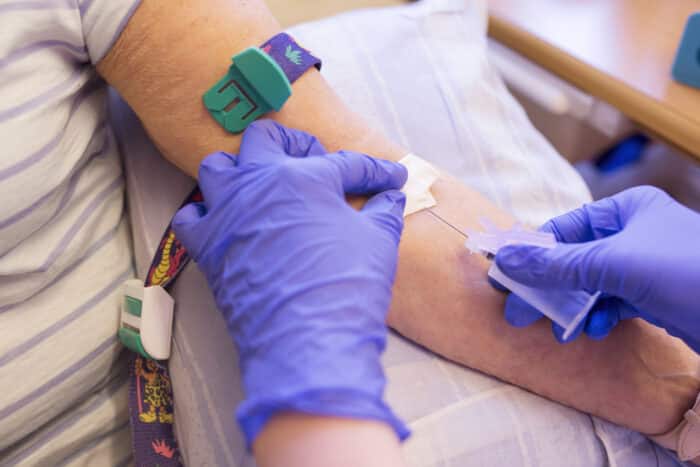Have you ever been curious about the world of healthcare and want to be part of a profession that plays a crucial role in patient care?
If so, becoming a phlebotomist might be the perfect fit for you.
Phlebotomists are the unsung heroes of the medical field, skilled in drawing blood and collecting samples that are essential for diagnosing and treating various health conditions.
In this article, we’ll take you on an exciting journey to explore the steps, skills, and opportunities that can lead you to a rewarding career as a phlebotomist, and how long it takes to become one.
Whether you’re just starting your career or looking to make a change, we’ve got you covered with all the information you need to know to become a successful phlebotomist and the time it takes to become one.
So, let’s get started!
Choosing the Right Training Program
The first and most important step that you need to take to become a phlebotomist is to browse through and choose the best training program for you.
Choosing the right training program is important for aspiring phlebotomists as it sets the base for a successful career in the healthcare field.
A good program will include a comprehensive and well-structured course that will impart all the necessary knowledge and skills you would need as a phlebotomist.
Choosing the right program will also include practical training opportunities, which is essential for phlebotomists since they need to perform venipunctures and blood draws on a regular basis.
Read more: What is a Phlebotomist
How Long is Schooling for a Phlebotomist?
Now that you know how important it is to choose the right training program for you, you might want to know the different types of programs available so you can pick one that suits you best.
And how long do phlebotomy training programs last?
We’re here to solve all of such queries.
There are two main ways in which you can complete your phlebotomy training, such as:
- Diploma or Certificate Programs-
Duration- Ranges between 4 weeks to 6 months
Cost- $1,500 to $5,000
Some community colleges or vocational schools offer short-term diploma or certificate programs for phlebotomists, which can be completed within a few weeks to a few months.
These programs equip aspiring phlebotomists with all the knowledge and skills required to become successful phlebotomists, both in theory and practical, including venipuncture and blood draws.
- Online Phlebotomy Programs-
Duration- 4 weeks to 4 months
Cost- $1,000 to $2,500
One of the most recommended methods of completing your phlebotomy training is to enroll in an online training program.
This is especially useful if you want to have more flexibility in your learning schedule, as online programs offer several advantages over other alternatives.
Some online programs also offer self-paced courses, wherein you get to decide your own pace and time schedule. So you can learn anytime and from anywhere.
Online programs are also the cheapest, which is financially helpful for students who don’t want to take the burden of student loans.
Additionally, online programs also allow you to complete your course much faster, so that you can get certified and join the workforce ASAP, in as little as 2 months!
One important thing to note is that you should ensure an online program is accredited and offers hands-on practical experience while choosing one.
Also read: Online Phlebotomist Classes
How to Become a Phlebotomist
If you’re still here, after reading all the available training program options for phlebotomists, you might be thinking about the process of becoming one.
Let us help you with that.
Here is a step-by-step guide on how to become a phlebotomist:
Step 1: Obtain a High School Diploma or GED
Having a high school diploma or equivalent qualification, such as a General Education Development (GED) certificate is considered to be the minimum requirement.
Step 2: Enroll in a Phlebotomy Training Program
As mentioned earlier, choosing the right training program can make you a successful phlebotomist.
The next step after obtaining your high school diploma is to enroll in a phlebotomy training program. You should also ensure the program provides comprehensive theoretical knowledge in addition to practical hands-on training.
Step 3: Get Practical Training
After you finish your phlebotomy training, the next step should be to gain practical experience in the form of either externships or internships. These are mostly provided by some online training programs after you finish their course.
Gaining practical experience is especially advantageous for aspiring phlebotomists as they handle venipunctures and blood draws regularly.
Step 4: Get Certification (Recommended)
Even though not necessary in most states, getting certified as a phlebotomist is highly recommended, since employers prefer certified candidates over uncertified ones.
You can obtain your phlebotomy certification from reputable organizations like the American Medical Technologists (AMT)), American Society for Clinical Pathology (ASCP), or National Healthcareer Association (NHA).
More on this in the next section.
All of these organizations offer certification exams with unique exam structures and durations, so it is important to go through each of them to decide which one is the best for you.
Read: Phlebotomy Certification
Step 5: Apply for Phlebotomy Jobs
Now that you have become certified as a phlebotomist, you can start applying for phlebotomy jobs at hospitals, clinics, laboratories, or other healthcare settings.
Types of Phlebotomy Certifications
There are many types of phlebotomy certifications available, which might be confusing for you to choose from.
We want to help you with that, that’s why we have created a list of the most common and legitimate phlebotomy certifications that are nationally recognized, such as:
- Phlebotomy Technician (PBT)-
The PBT certification is offered by the American Society for Clinical Pathology (ASCP). The PBT certification is one of the most preferred phlebotomy certifications by employers.
The eligibility criteria for the PBT certification include graduating with a high school diploma or having a GED and completing a phlebotomy program within the last five years.
You can also become eligible by completing a formal phlebotomy training program approved by ASCP individually or by working full-time as a phlebotomist in an approved lab for a year.
- Certified Phlebotomy Technician (CPT)-
The CPT certification is offered by the National Healthcareer Association (NHA). Like PBT, CPT is also one of the preferred certifications by employers.
The eligibility criteria for the CPT exam include to firstly complete a formal phlebotomy training program in the past five years. Or, if you have a high school diploma or GED and one year of supervised phlebotomy work experience in the last three years, you can still be eligible.
Also read: What is the Difference Between a Licensed Phlebotomist and Certified Phlebotomist?
- Registered Phlebotomy Technician (RPT)-
The RPT exam is offered by the American Medical Technologists (AMT).
The eligibility criteria for this certification exam usually include completing an accredited phlebotomy training program in the past four years, in addition to having worked at least 1,040 hours as a phlebotomist in the past three years.
Additionally, in order to become eligible to sit for the RPT exam, you will also need to complete a minimum of 50 successful venipunctures and 10 successful capillary punctures.

Do You Want To Become a Phlebotomist? Check Out Free Phlebotomist Masterclass!
In our masterclass you learn:
- How to be a Phlebotomist faster…in just 2 months!
- Avoid student debt & driving to classes
- #1 thing employers want from Phlebotomists
- How to stand-apart & get a university certificate for a strong resume
How to Decide Which Phlebotomy Certification is the Right for You
Now that you know the different types of phlebotomy certifications, it is common to get confused about which one to choose.
Don’t worry, we’re here to tell you how to choose one that suits you the best.
To choose the best certification, you can consider some of these factors.
First, check if the certification is widely recognized and accepted by employers in your area. Look for certifications from reputable organizations like the National Phlebotomy Association (NPA), American Society for Clinical Pathology (ASCP), or National Healthcareer Association (NHA).
Next, think about your career goals and the specific work settings that you want. For example, some certifications may be more suitable for certain healthcare environments.
Then, consider the cost and the requirements for each certification. Choose the one that aligns with your budget and the amount of time you can dedicate to preparation.
Finally, you can take advice from experienced phlebotomists or healthcare professionals to gain insights into the benefits and reputation of each certification to make an informed decision.
See: Phlebotomist Requirements
Skills Required to Become a Phlebotomist
Even though it is quite obvious that the main skill required to become a successful phlebotomist is to know how to draw blood efficiently, there are other skills you can develop that can help you increase your salary or job prospects.
Read more: Phlebotomist Skills
Let us take a look at some of the skills required by a phlebotomist, apart from drawing blood:
- Venipuncture Techniques- Phlebotomists need to be skilled in different types of venipuncture techniques to draw blood accurately and safely from patients’ veins.
- Medical Knowledge- Understanding basic anatomy, physiology, and the circulatory system is important for phlebotomists to interpret blood tests and handle different specimen types properly.
- Infection Control and Safety- Adhering to infection control protocols and safety guidelines is essential to minimize the risk of contamination and protect both patients and phlebotomists.
- Good Communication Skills- Good communication is important for interacting with patients, explaining procedures, answering questions, and providing instructions.
- Empathy and Compassion- Being empathetic and compassionate helps phlebotomists in easing their patients who may feel anxious or fearful.
- Attention to Detail- Paying close attention to detail ensures accurate labeling and documentation of blood samples and patient records.
See: Phlebotomist Salary
Conclusion
In conclusion, the journey to becoming a phlebotomist can vary in duration, but it’s generally a relatively quick path to a rewarding healthcare career.
On average, it takes about 4-8 months of training and education to become a certified phlebotomist. However, the actual time may depend on factors like your program’s length, your commitment, and any additional requirements in your state.
Related Resources:
- Traveling Phlebotomist
- Day in the Life of a Phlebotomist
- Ultimate Phlebotomist Resume Guide – Phlebotomy Job
- Phlebotomist Job Description
- Can A Phlebotomist Start IVs?
- Phlebotomist Duties
- Where Can a Phlebotomist Work?
- Phlebotomist Degree
- Pros and Cons of Being a Phlebotomist
- Mobile Phlebotomist
- How Long Does it Take to Get a Phlebotomy Certification?
- What are the Different Types of Phlebotomy Certifications?
- How Long is a Phlebotomy Course?
- Phlebotomist Cover Letter
- Phlebotomist Lab Technician
- Therapeutic Phlebotomy
- Certified Phlebotomy Technician
- Phlebotomy Classes
- Online Phlebotomy Classes
- Phlebotomy Certificate
- Cheap Phlebotomy Classes
- Study Guide Phlebotomy
- Pediatric Phlebotomy
Related Articles
-
How to Be Successful in College in 2022 – 7 Simple Tips to Succeed
-
How Do Scholarships Work? Read This First…Truth is Shocking
-
7 Best College Majors 2024: What Should I Major In?
-
How to Choose a College – 10 Things You Must Consider in 2024
-
Why Go to College? Top 13 Benefits for Adult Students in 2022
-
Top 5 Best Alternatives to Community College for 2024









